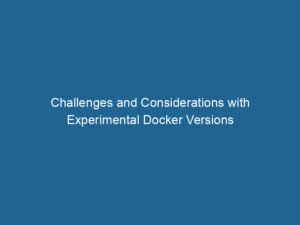The miscellaneous category encompasses a wide range of topics related to Docker, offering insights and solutions for various challenges and advanced use cases. This section includes tutorials, tips, and best practices that don’t fit neatly into other categories but are essential for mastering Docker and enhancing its functionality.
One common topic in this category is advanced DockerfileA Dockerfile is a script containing a series of instructions to automate the creation of Docker images. It specifies the base image, application dependencies, and configuration, facilitating consistent deployment across environments…. techniques. Writing efficient and maintainable Dockerfiles is crucial for optimizing containerContainers are lightweight, portable units that encapsulate software and its dependencies, enabling consistent execution across different environments. They leverage OS-level virtualization for efficiency…. performance and reducing imageAn image is a visual representation of an object or scene, typically composed of pixels in digital formats. It can convey information, evoke emotions, and facilitate communication across various media…. size. This involves using multi-stage builds to minimize the final image size, leveraging caching to speed up the build process, and following best practices for layer ordering to improve readability and maintainability. Tutorials in this area provide detailed guidance on creating optimized Dockerfiles for different types of applications.
Another important subject is Docker networking. While basic networking concepts are covered in other categories, the miscellaneous section delves into advanced networking scenarios. This includes setting up custom bridge networks, using overlay networks for multi-host communication, and configuring networkA network, in computing, refers to a collection of interconnected devices that communicate and share resources. It enables data exchange, facilitates collaboration, and enhances operational efficiency…. security. Understanding these advanced networking concepts is essential for managing complex applications that require secure and reliable communication between containers.
Docker Volumes and persistent storage are also frequently discussed topics. Managing data in Docker containers can be challenging, especially when dealing with stateful applications. This section covers best practices for using Docker volumes to persist data, sharing data between containers, and configuring storage backends. Additionally, tutorials on using Docker with databases, such as PostgreSQL, MySQL, and MongoDB, provide practical insights into managing data within containers.
Integrating Docker with other tools and technologies is another common theme. Docker’s versatility allows it to be used in conjunction with a wide range of tools, from monitoring and logging solutions like Prometheus and ELK StackA stack is a data structure that operates on a Last In, First Out (LIFO) principle, where the most recently added element is the first to be removed. It supports two primary operations: push and pop…., to development frameworks and CI/CD pipelines. Tutorials and articles in this category explore how to integrate Docker with these tools, providing step-by-step instructions and real-world examples.
Security is a critical aspect of Docker, and the miscellaneous section often includes advanced security practices. This involves configuring Docker to run“RUN” refers to a command in various programming languages and operating systems to execute a specified program or script. It initiates processes, providing a controlled environment for task execution…. with least privilege, using security scanning tools to detect vulnerabilities in images, and implementing access controls. Additionally, topics such as namespace isolation, capabilities, and SELinux/AppArmor profiles are covered to help users secure their Docker environments.
Lastly, troubleshooting and debugging are essential skills for any Docker user. This section provides tips and techniques for diagnosing and resolving common Docker issues. From interpreting Docker logs and inspecting container states, to using tools like docker inspect and docker stats, these resources equip users with the knowledge to effectively troubleshoot problems and maintain healthy Docker environments.
In summary, the miscellaneous category serves as a catch-all for a variety of advanced and practical Docker topics. By exploring these resources, users can gain a deeper understanding of Docker, improve their containerization practices, and effectively tackle complex challenges.

